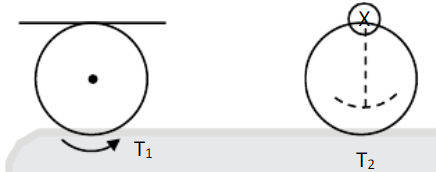A ring is hung on a nail. It can osicallate without slpping or sliding (i) in its plance with atime period T1 and (ii) , back and forth in a direction perpendicular to its plane , with a period T2. The ratio T1T2 will be :
2√3
23
3√3
√23
To solve the problem, we need to find the ratio of the time periods T1 and T2 for the oscillations of a ring hung on a nail. The ring oscillates in two different modes: (i) in its own plane with a time period T1 and (ii) back and forth in a direction perpendicular to its plane with a time period T2.
1. Understanding the System:
- We have a ring of mass m and radius r hung on a nail, allowing it to oscillate in two different modes.
- The oscillation in its own plane (horizontal plane) corresponds to T1.
- The oscillation back and forth in a direction perpendicular to its plane corresponds to T2.
2. Moment of Inertia Calculation:
- For oscillation in the plane of the ring (horizontal plane), we need to find the moment of inertia I1 about the vertical axis (the axis through the nail).
- Using the parallel axis theorem, the moment of inertia I1 can be calculated as:
I1=Icm+md2=12mr2+m⋅r2=32mr2
3. Finding the Time Period T1:
- The angular frequency ω for simple harmonic motion (SHM) is given by:
ω=√kI
- The time period T1 is given by:
T1=2π√I1k
- Here, k is the effective spring constant for the oscillation in the plane of the ring.
4. Moment of Inertia for Perpendicular Oscillation:
- For oscillation back and forth (perpendicular to the plane), we need to find the moment of inertia I2.
- The moment of inertia I2 about the horizontal axis can be calculated as:
I2=Icm+md2=12mr2+m⋅(r2)2=12mr2+14mr2=34mr2
5. Finding the Time Period T2:
- The time period T2 is given by:
T2=2π√I2k
6. Finding the Ratio T1T2:
- Now we can find the ratio of the time periods:
T1T2=2π√I1k2π√I2k=√I1I2=
⎷32mr234mr2=√3/23/4=√2=2√3
7. Final Answer:
- Thus, the ratio T1T2 is:
T1T2=2√3
- We have a ring of mass m and radius r hung on a nail, allowing it to oscillate in two different modes.
- The oscillation in its own plane (horizontal plane) corresponds to T1.
- The oscillation back and forth in a direction perpendicular to its plane corresponds to T2.
- For oscillation in the plane of the ring (horizontal plane), we need to find the moment of inertia I1 about the vertical axis (the axis through the nail).
- Using the parallel axis theorem, the moment of inertia I1 can be calculated as:
I1=Icm+md2=12mr2+m⋅r2=32mr2
- The angular frequency ω for simple harmonic motion (SHM) is given by:
ω=√kI
- The time period T1 is given by:
T1=2π√I1k
- Here, k is the effective spring constant for the oscillation in the plane of the ring.
- For oscillation back and forth (perpendicular to the plane), we need to find the moment of inertia I2.
- The moment of inertia I2 about the horizontal axis can be calculated as:
I2=Icm+md2=12mr2+m⋅(r2)2=12mr2+14mr2=34mr2
- The time period T2 is given by:
T2=2π√I2k
- Now we can find the ratio of the time periods:
T1T2=2π√I1k2π√I2k=√I1I2=
⎷32mr234mr2=√3/23/4=√2=2√3
- Thus, the ratio T1T2 is:
T1T2=2√3
Topper's Solved these Questions
Similar Questions
Knowledge Check
The point of suspension λ of a simple pendulum with normal time perid T1 is moving upward according to equation y=kt2 where k=1m/s2. If new time period is T2 the ratio T21T22 will be
A2/3B5/6C6/5D3/2A simple pendulum has a time period T1 on the surface of earth of radius R. When taken to a height of R above the earth's surface, its time period is T2, ratio T2T is
A1√2B√2C2D4A ring-1 oscillate with period T1 about tangential axis in the plane of ring and an another ring-2 oscillate with period T2 about tangential axis tangential axis perpendicular to plane of ring T1T2?
 A√34B√58C√85D√43
A√34B√58C√85D√43
The time period of a simple pendulum, in the form of a hollow metallic sphere, is T. When it is filled with sand and mercury, then its time periods are T1andT2 respectively. When it is partially filled with sand then its time period is T3. The correct relation between T1,T2&T3 will be
View SolutionA uniform spring has certain mass suspended from it and its period for vertical oscillation is T1. The spring is now cut into two parts having the lengths in the ratio of 1:2 and same mass is suspended with those two spring as shown in figure. Now time period is T2. The ratio T1/T2 is

View SolutionThe time period of a simple pendulum is T. When the length is increased by 10 cm, its period is T1. When the length is decreased by 10 cm, its period is T2. Then, the relation between T, T1 and T2 is
View SolutionTwo planets move around the sun. The periodic times and the mean radii of the orbits are T1,T2 and r1r2 respectively. The ratio T1/T2 is equal to
View SolutionWhat is the ratio of time periods (T1/T2) in second orbit of hydrogen atom to third orbit of He+ ion?
View Solution
